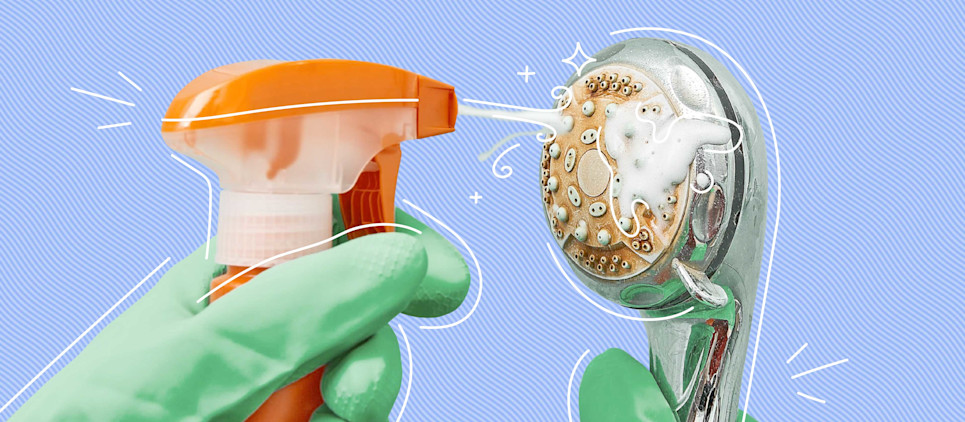How to restore a shower head to its former glory
If you’ve felt a consistent drop in water pressure, an irregular distribution pattern, or noticed a bit of white build-up or film around the small holes in the filter screen of the shower head—well, it’s time to clean it.
Mineral buildup is usually the culprit behind a slow shower head. When hard water passes through the small holes of a shower head, it leaves behind a deposit which hardens and dries in-between uses. Multiply that by however long you’ve spent daydreaming in the shower, and you’ll get the picture: there’s probably a lot of build up there.

Table of contents
What To Know About Mineral Build-Up2 Ways To Clean a Shower HeadWhat To Know About Mineral Build-Up
Water is classified as “hard” when it contains high levels of minerals like magnesium, lime, and calcium. This is especially common with water that comes from wells, as minerals are drawn from soil and rocks as the water passes underground. Depending on where you live, you may find yourself adding a few extra steps to your shower maintenance routine.
The shower head isn’t the only place mineral deposits like to hang out. If your shower has glass walls, they’ll become cloudy or streaky over time. (The same goes for ceramic walls and floors, though it’s harder to see.) Hard water can even take a toll on hair and skin.
Those minerals are also what makes soap scum so persistent: The mineral deposits left behind in all those nooks and crannies—not just the corners and tile but the inside of the drains, too—adhere to soap residue and harden as they dry. Regular cleaning with distilled white vinegar and water will keep it at bay. To keep it in check on a daily basis, stash a squeegee in the shower and give all the glass surfaces a good wipe down before you step out.
2 Ways To Clean a Shower Head
1. Soak it in vinegar. Vinegar is a solution of acetic acid and water, and although it is not on the list of registered disinfectants, vinegar does have some disinfecting qualities. Its purpose here is less about strictly disinfecting and more about breaking up deposits. Acetic acid is a powerful solvent, especially when faced with relatively soft mineral deposits.
Step 1: If your shower head can be easily removed, do so and soak it overnight in a bowl of equal parts distilled white vinegar and warm water. To remove the shower head, use a plumber’s adjustable wrench or a pair of pliers to rotate the nut connecting the shower head to the arm counter-clockwise. (If your shower head is new or in relatively good shape, you may be able to do this by hand.) If you’re having trouble gaining traction, try a small spray of WD-40 to help lubricate the threads.
Step 2: If you can’t find a way to remove the shower head, simply fill a plastic bag with the cleaning solution and fasten it tightly around the arm of the shower so that the holes are fully submerged. Secure the bag with a rubber band or twist tie. Carefully remove the bag in the morning.
Step 3: Address any remaining debris with a toothpick, and wipe down with a wet cloth or sponge. Turn on the water, and note whether the water flow has improved.
2. Use a chemical cleaner. If you’re dealing with fairly heavy build-up and a bag with vinegar hasn’t quite done the trick, it’s time to try the harsher chemicals.
CLR, as its name might suggest, excels at removing mineral deposits: Specifically, calcium, lime, and rust. You won’t need to soak the shower head overnight—CLR works in a matter of minutes, so follow the recommended timing on the bottle with the steps above, then try gently scrubbing with a sponge or stiff brush to loosen any build-up.
Looking for a home where monthly cleaning is always on the books? Bungalow offers private rooms in shared homes that are more affordable than solo housing options in the same neighborhoods. Wifi, utilities, and monthly cleaning are set up before you move in so that communal living is seamless. Find a Bungalow near you.
Ready to find your next home?
Move-in ready homes and a built-in community so you can feel at home, together — wherever you are.
Suggested articles



